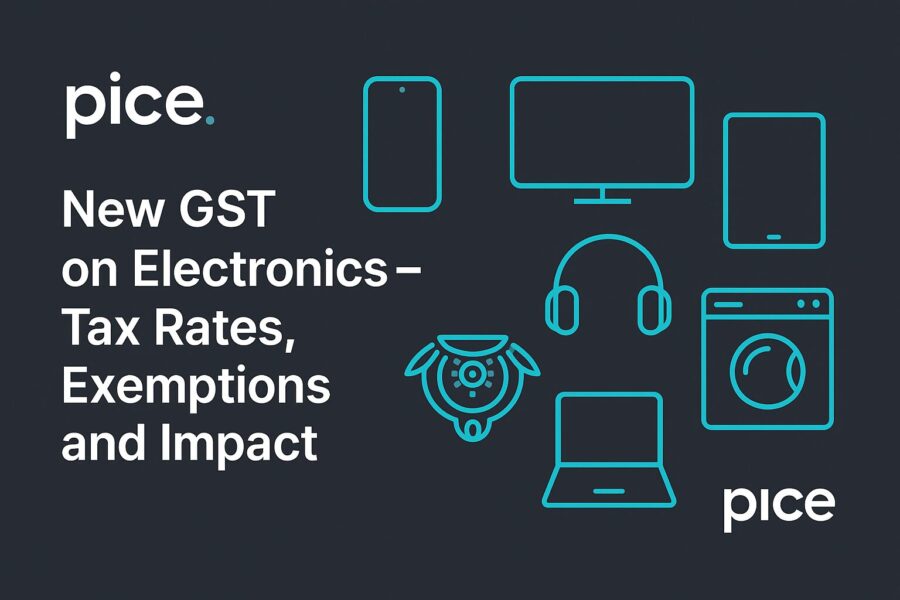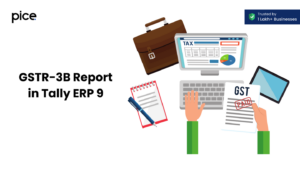New GST on Electronics – Tax Rates, Exemptions, and Impact
- 13 Nov 25
- 8 mins

New GST on Electronics – Tax Rates, Exemptions, and Impact
Key Takeaways
- GST on electronics in India ranges from 5% to 28%, depending on the type, size, and utility of the product.
- Most consumer electronics like TVs, ACs, and refrigerators attract 18%–28% GST, making them costlier for buyers.
- Electric vehicles and chargers enjoy just 5% GST, promoting cleaner and sustainable mobility.
- GST has simplified taxation on electronics, replacing multiple levies like VAT, excise duty, and service tax.
- High GST rates impact affordability and demand, urging manufacturers to seek lower rates and import duty relief.
In recent years, India has seen a steep rise in technology and the internet. The Indian tech industry is booming right now, and the market expects this industry to reach the $350 billion mark by 2026. None of this industry can survive without electronic items.
Electronics are the foundation of digital growth in India, making it a very crucial part of the Government’s revenue from taxes. The rate of GST on electronics ranges from 5% to 28%. Being a major factor for tax revenue, the rate on electronics is comparatively a little high.
Further in this blog, we are going to learn about the Impact of GST on electronics and its rate for various electronic items.
What Do You Mean By GST on Electronics?
The introduction of GST in 2017 replaced multiple indirect taxes from the previous tax regime, such as VAT, Service Tax and Excise Duty. Since then, this is the only tax levied on the purchase of items.
However, the GST rate varies from one electrical item to another. The rate of taxes on different items is set by the GST Council based on the HSN code system. Hence, according to the GST Council, GST on electronics and electrical items fall under 5 GST rate slabs, which are 0%, 5%, 12%, 18%, and 28%.
The 56th GST council meeting is set to happen in July 2025. This meeting can be a turning point for the electronics industry as it may influence consumer behaviour in this industry with a single revision in rates.
Rate of GST for Various Electric and Electronic Items
When it comes to electrical and electronic items, there are a large number of items in this list. However, the GST rate structure on these electronic items vary.
Here is a table representing the rate of GST on various electronic items:
| Type of Electronic Item | Rate of GST Levied | HSN Codes |
| EV or Electronic Vehicles | 5% GST | 87 |
| Chargers for Electric Vehicles | 5% GST | 8504 |
| Biogas Plant for factories | 12% GST | 84, 85, 94 |
| Electronic items running on solar energy, like solar lanterns | 12% GST | 84, 85, 94 |
| Solar-powered Generators | 12% GST | 84, 85, 94 |
| Windmills or Wind Operated Electricity generator | 12% GST | 84, 85, 94 |
| Solar-powered water heater and system | 12% GST | 8419 12 |
| Waste to Energy Plants and devices | 12% GST | 84, 85, 94 |
| Water Energy device or plants | 12% GST | 84, 85, 94 |
| Photovoltaic cells | 12% GST | 84, 85, 94 |
| Electronic items used in medical and veterinary science organisations | 12% GST | 9018 |
| Television set up to 32 inches screen size | 18% GST | 8528 |
| Mobile Phones | 18% GST | 8517 |
| Refrigerators | 18% GST | 8418 |
| Printers | 18% GST | 8443 |
| Camera | 18% GST | 9006-9007 |
| Electronic water purifiers | 18% GST | 8421 |
| Electronic equipment for machines, plants, and laboratories | 18% GST | 8419 or 8419 12 |
| Electricity capacitors | 18% GST | 8532 |
| Vacuum Cleaners | 18% GST | 8508 |
| Transformers and static electricity converters | 18% GST | 8504 |
| Electrical Iron, Water heaters and hair dryers | 18% GST | 8516 |
| Electrical vocal items such as speakers and headphones. | 18% GST | 8518 |
| Electrical washing machines | 18% GST | 8450 |
| Electric motors and generators | 18% GST | 8501 |
| Electro-magnets | 18% GST | 8505 |
| Home electrical circuit parts such as switches, relays and fuses. | 18% GST | 8535 or 8536 |
| Electric musical instruments | 18% GST | 9207 |
| Lighters | 18% GST | 9613 |
| AC or Air Conditioners | 28% GST | 8415 |
| Computer monitors and projectors | 28% GST | 8528 |
| Television sets bigger than 32 inches screen size | 28% GST | 8528 |
| Electrical Dishwashing Machines | 28% GST | 8422 |
| Electrical ignition | 28% GST | 8511 |
| Electric accumulators and separators | 28% GST | 8507 |
Note: The GST council set a lower percentage on GST on electronic vehicles to promote an environment-friendly option instead of petrol and diesel vehicles.
Impact of GST on the Electronics Industry
Prior to 2017, there were multiple indirect taxes. It is hard to compare the impact of both these taxation systems and select a profitable one.
However, the introduction of the GST regime in the Indian taxation system has certainly played a big role in streamlining the taxation process. GST is a single domestic indirect tax for the entire country. This offers equality and breaks redundancy, making it easy for taxpayers to comply with.
Electrical products are still considered a luxury for the Indian market. This is the reason why most electronic items have high GST rates, where most items come under 12% or 28% tax slabs. Experts also anticipate a hike in the price of consumer electronic items such as TVs, ACs, refrigerators, etc, because of an increased tax rate and ever-rising inflation.
Impact of GST Rates for Electronics on Consumers
The rate of GST on electronics, especially consumer electronic items, has seen a hike in recent years, and there is a probability of a further rise in upcoming years. This becomes a major burden for people in India and a good reason for them to postpone their purchase of electronics.
Suppose you decide to buy an Air Conditioner worth ₹40,000. Now, the GST Council levies 28% GST on ACs. This means you will have to pay a GST of ₹11,200 (40,000*28%) on top of the ₹40,000, making your total payable amount to ₹51,200 (40,000+11,200). This major change in price surpasses a lot of people’s affordability.
The companies dealing with electronic items have shown their concern for lowering the tax rates for certain electronic items. They also show concern for waiving off import duty on semi-finished electronic parts. A relief in these taxes and duties can help to reactivate the dormant market for electronic items.
Factors Influencing GST Rates on Electronics and Electrical Items
The GST Council determines the GST rate levied on various electronic items based on their utility and function. It also depends on the size and capacity of the item. Here is a list of factors influencing these rates:
- Utility
The GST rate on an item depends on the function of that item or the utility of that item. Moreover, some electronic items mainly satisfy the luxurious demands of people. These types of luxurious items attract comparatively higher rates of GST.
- Size
Size is also one of the deciding factors for the GST rate of an item. For instance, an electronic industrial machine or a high-energy-consuming item might attract higher tax rates.
- Advancements
Newer models of an electrical item with modern features can also attract higher tax rates. These advancements can be on the increase in the capacity of an item or other development in its structure.
Conclusion
The electronics Industry in the Indian market is a huge source of revenue for the Indian government. However, the taxes and duties charged on the manufacture and final purchase of these electronic items are concerning for large electronic industries as they have greatly increased their products’ prices and simultaneously reduced their market reach.
The rate of GST on electronics is levied by the GST Council based on the HSN codes ((Harmonised System of Nomenclature) system and is variable. Business owners who are into selling electronic items should keep themselves updated with changes in Goods and Services Tax rates to comply with GST rules.
💡If you want to streamline your payment and make GST payments via credit, debit card or UPI, consider using the PICE App. Explore the PICE App today and take your business to new heights.
 By
By 

















